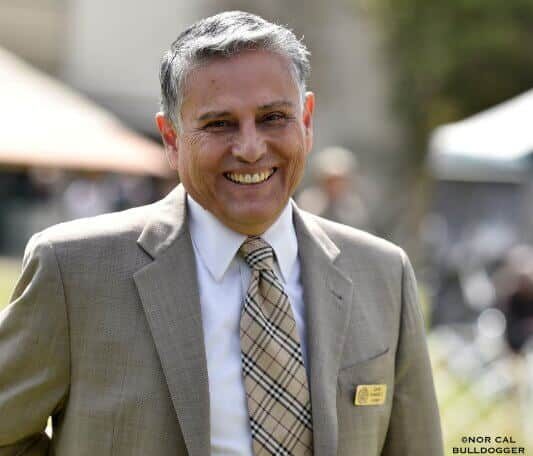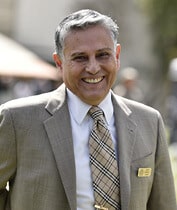Interview with Working Group Judge John Ramirez
Where do I live? How many years in dogs? How many years as a judge?
John Ramirez: I currently reside in Downey, California, and have been involved in dogs all my life, ranging from strays to purebreds.
I am often asked how long I have been judging, and to be honest, I don’t know. I posed a question to Judging Operations today, asking that question. My guess is, somewhere between 1972 and 1975; so guessing, I think, around 47 years.
What is my original breed? What is/was my kennel name?
John Ramirez: My original breeds were the St. Bernard and the Skye Terrier. My kennel name was Agonistes, coming from the Greek meaning Champion of Champions. At the time, I was studying English literature. Thus, the name from Milton’s, Samson Agonistes.
Can I list a few of the notable dogs I’ve bred? Any performance or parent club titles?
John Ramirez: Most notable dogs were mainly dogs co-owned with others, and at the time, being young and dumb, co-ownerships did fare well. Also, at the time, Saints were all over and in excess. The outfit, Saint Chalet, and several backyard breeders who were out to make a buck filled the market with less-than-quality Saints. Breeding at that time was not for me.
If there were any dogs of note, I would have to say they were the Skyes, my English Toy, and the Chihuahuas. Though I must admit, I’ve always remained loyal to my Working breed roots.
What are the qualities I most admire in the Working breeds?
John Ramirez: I greatly appreciate the historical aspect of the breeds, their original purpose, and the conditions they must have endured.
Have I judged any Working Group Specialties?
John Ramirez: I have judged several over the years, especially in my breed, Saints, in addition to Sammies, Dobies, Boxers, Siberians, the Black Russian, Berners, Newfs, Rotties, Std. Schnauzers, and Porties.
Do I find that size, proportion, and substance are correct in most Working breeds?
John Ramirez: LOL, that’s a loaded question. Overall, I might agree with the above and say, “Yes.” But in reality, several of the breeds have fallen victim to over-refinement and overly exaggerated features. In general, while still possessing physical abilities, they would be unable to perform in their original functions in situations such as draft or sled dogs working in harsh, cold, wet, and rocky terrains. Beauty and fashion now dictate what goes into the ring. I love “pretty,” but breed essence and breed type must prevail.
Is breed-specific presentation important to me as a judge? Can I offer some examples?
John Ramirez: In a Working Dog, other than movement, what would be breed-specific presentation? Do I want to see a Saint, Berner or Mastiff racing around like a Boxer or Dobie? NO! Would I want to see a Mastino racing around the ring upright, and moving upright like any generic dog? NO!
What are my thoughts on cropping/docking the Working breeds?
John Ramirez: Where such practices are the norm, I truly believe that cropping and docking add to the profile and beauty to the breed. I would hate to see it banned. I have judged overseas often enough to learn to overlook natural ears and tails and I can appreciate the uncropped/undocked exhibit. For Americans, this practice has become the norm and what we are accustomed to seeing. I have used both, but, not wanting to sound the hypocrite, I hope we never change.
Are the Working breeds in good shape overall? Any concerns?
John Ramirez: Again, other than falling victim to trends, the breeds remain in good shape overall. I am very elated to see the progress that Mastiffs have made, from near extinction to “sound” top contenders in a Group ring. I recall the days when they could hardly stand.
Concerns? The Neo. Today we are seeing more and more of the breed (though maybe not too many), which thrills me. However, I was always instructed that we look upon this breed in awe. In the past, I recall so much more wrinkle on the head, elbows, the body… everywhere. I see them losing this. Movement? Again, what is happing to their lumbering movement? Their standard clearly describes their lumbering gait. This is another thing they are losing—in the hopes of being more competitive. They are starting to move like generic animals; a clear lacking of essence and type. I want to be in AWE when a Mastino comes lumbering towards me.
Saints appear to be losing too much leg, and have too much focus on the head. There must be balance. Also, there is way too much “paddling.” It would be difficult to make much progress in snow or anywhere else. They should stand like stallions, and likewise, be structured to move with power, reach, and drive.
There are other breeds I would like to mention and give MY concerns. I mention these three since I have watched them with appreciation and concern for a very long time.
In my opinion, how do today’s exhibits compare with the Working Dogs of the past?
John Ramirez: In my breed, I long reminisce of the past greats, starting with Titan, Ursula, The Diva, Ben, Frederick, Caspar, Arie, Bullseye, If Only, Going My Way… all beautiful Group competitors. None were seriously exaggerated. Then there was a dry spell when seldom a Saint was even seen as being competitive in Group competition.
The times, they are a-changin’. Several worthy exhibits are coming out of the woodwork. I have heard them referred to as “old-fashioned,” but many of the Smooths are blessed with leg, athletic bodies, and proper balance and proportion, with good reach and drive, no paddling, and no overly exaggerated features. Kudos to those breeders on the resurgence of competitive examples of this breed.
Other breeds (with the loss of the great kennels, breeders, and mentors of the past—in all breeds) have gone through changes (FADS) and it sometimes becomes apparent that last year’s dogs differ from the current ones. Preservation breeders, where are you? We must work within the confines of the original standards, not adapt them to today’s whims, changes, and fashions.
Why do I think the Working breeds are so admired as family companions?
John Ramirez: The nobleness of the Dane, the lovingness of the St. Bernard or Newfoundland, the gentleness of the Mastiff. What’s not to admire? Every breed in the Working Group has always been admired as a companion, whether in the field or on rocky terrain. But with all that put aside, they end up at home with family.









